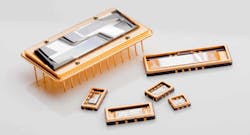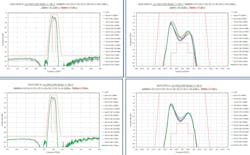High-Power SAW Filters Meet Demands of Modern Military, Space, and Commercial Systems
What you’ll learn:
- The evolution of SAW filters.
- SAW vs. alternative filtering techniques.
- How the latest SAW filters can empower advanced wireless designs.
The RF spectrum is becoming overcrowded due to the prevalence of commercial and military/aerospace systems utilizing multiple technologies, contaminating the spectrum. In addition, military, space, and commercial systems often integrate digital and analog technologies in the same package, creating greater interference concerns. Meanwhile, modern communications systems continue to become more compact and lightweight, with stringent size, weight, power, and cost (SWaP-C) parameters, leading to greater interference issues.
To address the challenges of our ever-more crowded wireless landscape, filtering techniques on the RF front-end take on a greater significance. Traditional surface-acoustic-wave (SAW) filters have been unable to address the high-power RF surges from many sources common in modern systems.
A new generation of SAW filters is breaking the old design paradigm and helping RF engineers effectively address interference. These high-power SAW filters are smaller, lighter, and more economical than comparable filter technologies such as lumped element, cavity, and suspended substrate.
SAW Filter Evolution
SAW filters have been used to mitigate interference for decades. They convert electrical energy into acoustic or mechanical energy on a piezoelectric material. A transducer generates a tuned acoustic wave to amplify the desired signal and attenuate all others. Each transducer consists of periodic interdigital electrodes connected to two bus bars.
One key advantage of SAW filters is they have large rejection bandwidths, so they can filter out closely adjacent signals. This filtering technology also offers low insertion loss and high selectivity.
While SAW filters have excellent performance in low-power applications, similar success has proven elusive in emerging high-power designs. As electronic warfare (EW), base stations, radar, and similar communications systems became digitized, operating at higher frequencies with greater bandwidth, conventional SAW filters were unable to address the associated high input power. RF energy increases the temperature of traditional SAW filters to such an extent that they would fail catastrophically.
Advanced SAW Filter Technology for Today’s Designs
A new generation of SAW filters (Fig. 1) that supports high input power is now available. These SAW filters leverage innovative material science and advanced substrates to meet the high input and output demands of modern systems.
The new high-power SAW filters can handle up to 5X as much power as legacy SAW filters. Improved performance is created by these design/manufacturing techniques:
Innovative materials formula: An advanced materials formula along with an additional metallization layer creates improved thermal conductivity at higher power levels while maintaining bandwidth and low insertion loss.
Advanced substrates: The main substrates used in the new SAW filters are lithium niobate (LiNbO3) and lithium tantalate (LiTaO3). These inorganic compounds are highly effective options to mitigate alkali-silica reaction (ASR) and make the filters very durable and rugged. For certain higher-frequency requirements, synthetic diamond, thin film, and glass substrates can be used, too.
Packaging: Filters and oscillators are hermetically sealed in the SAW filter. Oscillators have fundamental frequencies up to 1,200 MHz, which provides superior phase-noise performance and vibration sensitivity. This method maintains environmental integrity to pass the rigors of MIL-STD-883 Method 1014 Conditions A and C for both gross and fine leak detection.
By taking such an approach, the SAW filters can serve as a time- and money-saving drop-in replacement for current low-power-handling SAW filters. No custom PCB layouts for thermal considerations are required and standard reflow profiles could be used. For new designs, the small footprint can also lead to smaller board designs. This leads directly to a reduction in components, lower BOM costs, faster assembly, and lighter weight.
High-Power Performance, High-Quality Standards
The innovative design and materials science help the SAW filters achieve high power input up to +35-dBm continuous wave (CW) at +125°C and cover narrow, wide, and fractional bandwidths across frequencies of 20 MHz to 1.6 GHz (Fig. 2). This level of performance is achieved without degradation of the filter’s key parameters, including center frequency, bandwidth, insertion loss, and ripple.
It’s important to note that the SAW filter’s high input power should be tested at CW. Since peak power is pulse-based, it’s not an accurate depiction of real-world environments. Because CW is constant, it more precisely replicates how the filter will handle power when integrated in a system.
The highest quality-control standards should be maintained at every stage of the product ecosystem, from initial design through manufacturing and delivery. All processes must have a high level of quality assurance to ensure the filters will operate according to specification when designed into a system.
To ensure reliability and consistency, every SAW filter needs to be electrically tested for critical parameters, such as center frequency, insertion loss, bandwidth, and rejection. Characterizing SAW filters at 125°C and CW for 1,000 hours gives engineers confidence that they will meet commercial, military, and space specifications.
Figure 3 shows results of SAW devices that went through rigorous testing. The devices were tested for 760 hours at +37 dBm (5 W) at 125°C. Input power for both samples was initiated at +33 dBm. Power was steadily increased, as shown in the plots on the right side, until +37 dBm was reached.
SAW vs. Alternative Filtering Techniques
The new high-power SAW filters can be an attractive design choice compared to other filtering options, such as bulk-acoustic-wave (BAW) filters, hybrid filters, and lumped elements:
BAW filters: A common alternative, BAW filters support frequencies above 1.4 GHz. BAW performance has been known to suffer at lower frequencies, limiting the applications in which they can be used. In addition, BAW filters handle power by channeling the acoustic wave through the bulk of the substrate, requiring the metallized structures and substrates to be stacked on top of each other. In a SAW filter, the acoustic wave is channeled across the top of the substrate surface.
Hybrid filters: A hybrid solution integrates a passive filter with an active filter. The passive power filter addresses the low-order harmonic current while the high-order harmonics are addressed by the active power filter.
Lumped elements: Lumped-element filters are passive filters that consist of the necessary inductors (Ls), capacitors (Cs), and resistors (Rs) for the specific design requirements. These technologies can handle the input power requirements but have other design tradeoffs.
All of these are much larger than a SAW filter, and typically occupy up to 10X more space compared to a SAW filter. SAW filters are also lighter and more cost-efficient compared to the other filter technologies. Considered together, these features offer system designers significant advantages for using high-power SAW filters.
Meeting Today’s Systems Needs
The ability of the new SAW filters to achieve input power of up +35 dB (compared to +20 dB for conventional SAW filters) make them ideal for emerging space, commercial, and military systems (see table) that rely on digital technologies and clean transmissions. High-power SAW is also an attractive complement for designs using low-noise amplifiers (LNAs) that integrate analog technologies.
Overcoming Signal Interference with SAW Filters
Increased RF clutter from an overcrowded RF spectrum, coupled with a mixture of analog-digital technologies in smaller designs, are creating increased signal interference challenges for a growing number of commercial, military, and space designs. A new generation of high-power SAW filters enables higher power and tighter bandwidths in a compact design with a wide temperature range, providing an efficient solution to modern interference concerns.






